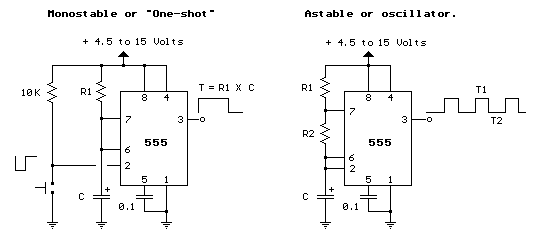Enter values for R1, R2, and C and press the calculate button to solve for positive time interval (T1) and negative time interval (T2). For example, a 10K resistor (R1) and 100K (R2) and 0.1 uF capacitor will produce output time intervals of 7.62 mS positive (T1) and 6.93 mS negative (T2). The frequency will be about 70 Hz. R1 should be greater than 1K and C should be greater than .0005 uF. Scroll down page for basic 555 information (pinout and two basic circuits).
Positive Time Interval (T1) = 0.693 * (R1+R2) * C
Negative Time Interval (T2) = 0.693 * R2 * C
Frequency = 1.44 / ( (R1+R2+R2) * C)
The 555 Timer
First introduced by the Signetics Corporation as the SE555/NE555 about 1971.
Pin connections and functions: (See schematic below for basic circuits)
Pin 1 (Ground) - The ground (or common) pin is the most-negative supply potential
of the device, which is normally connected to circuit common when
operated from positive supply voltages.
Pin 2 (Trigger) - This pin is the input which causes the output to go high and begin
the timing cycle. Triggering occurs when the trigger input moves
from a voltage above 2/3 of the supply voltage to a voltage below
1/3 of the supply. For example using a 12 volt supply, the trigger
input voltage must start from above 8 volts and move down to a
voltage below 4 volts to begin the timing cycle. The action is
level sensitive and the trigger voltage may move very slowly. To
avoid retriggering, the trigger voltage must return to a voltage
above 1/3 of the supply before the end of the timing cycle in the
monostable mode. Trigger input current is about 0.5 microamps.
Pin 3 (Output) - The output pin of the 555 moves to a high level of 1.7 volts less
than the supply voltage when the timing cycle begins. The output
returns to a low level near 0 at the end of the cycle. Maximum
current from the output at either low or high levels is
approximately 200 mA.
Pin 4 (Reset): - A low logic level on this pin resets the timer and returns the
ouput to a low state. It is normally connected to the + supply
line if not used.
Pin 5 (Control) - This pin allows changing the triggering and threshold voltages by
applying an external voltage. When the timer is operating in the
astable or oscillating mode, this input could be used to alter or
frequency modulate the output. If not in use, it is recommended
installing a small capacitor from pin 5 to ground to avoid
possible false or erratic triggering from noise effects.
Pin 6 (Threshold) - Pin 6 is used to reset the latch and cause the output to go low.
Reset occurs when the voltage on this pin moves from a voltage
below 2/3 of the supply to a voltage above 2/3 of the supply.
The action is level sensitive and can move slowly similar to the
trigger voltage.
Pin 7 (Discharge) - This pin is an open collector output which is in phase with the
main output on pin 3 and has similar current sinking capability.
Pin 8 (V +) - This is the positive supply voltage terminal of the 555 timer IC.
Supply-voltage operating range is +4.5 volts (minimum) to +16
volts (maximum).
The pin connections for the 556 which is a dual 555 timer (2 in one package) are
shown in table below. For example, the two outputs for the two timers of the 556 are
on pins 5 and 9 which correspond to the output pin 3 of the 555.
555 556 timer #1 timer #2
-------------------------------------------------------
Ground 1 7 7
Trigger 2 6 8
Output 3 5 9
Reset 4 4 10
Control 5 3 11
Threshold 6 2 12
Discharge 7 1 13
+ Power Vcc 8 14 14
-------------------------------------------------------
The schematics below show the two basic circuits for the 555 timer.

Below is a pictorial view of the 555 timer wired as a LED flasher and powered with a 9 volt battery. The LED will turn on during time T1 and off during time T2.

The 555 circuit below is a flashing bicycle light powered with three C or D
cells (4.5 volts). The two flashlight lamps will alternately flash at a
approximate 1.5 second cycle rate. Using a 4.7K resistor for R1 and a 100K
resistor for R2 and a 4.7uF capacitor, the time intervals for the two lamps
are 341 milliseconds (T1, upper lamp) and 326 milliseconds (T2 lower lamp).
The lamps are driven by transistors to provide additional current beyond the
200 mA limit of the 555 timer. A 2N2905 PNP and a 2N3053 NPN could be used for
lamps requiring 500 mA or less. For additional current, a TIP29 NPN and TIP30
PNP could be used up to 1 amp. A PR3 is a 4.5 volt, 500 mA flashlight bulb.
Two diodes are placed in series with the PNP transistor base so that
the lower lamp turns off when the 555 output goes high during the T1 time
interval. The high output level of the 555 timer is 1.7 volts less than the
supply voltage. Adding the two diodes increases the forward voltage required
for the PNP transistor to about 2.1 volts so that the 1.7 volt difference
from supply to the output is not enough to turn on the transistor. You can
also use an LED in place of the two diodes as shown in the lower schematic.
40 LED Bicycle Light

